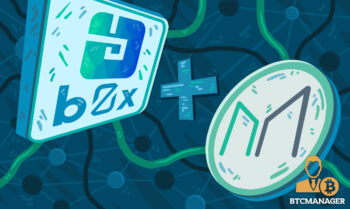
2018-7-26 20:00 |
bZx and MakerDAO are announcing a partnership where they plan to bring their protocols together, to enable decentralized trading using smart contracts running on the Ethereum blockchain.
While bZx is a decentralized margin lending protocol and liquidation oracle marketplace on the Ethereum blockchain, MakerDAO is the firm that developed the Dai stablecoin. MakerDAO was the first company introducing the concept of a stable coin. Much like Tether, its currency Dai is not mineable and is valued at 1 USD. The main difference between Dai and Tether is that Dai is crypto-collateralized.
According to a medium post by the bZx team, the companies have joined their efforts to develop a platform that will use both the bZx and MakerDAO altogether. With this partnership, MakerDAO will be able to introduce the 0x-standard DEXs to full feature parity with centralized exchanges.
Partnership Main Focus
bZx and Maker will work in three areas of potential integration:
1- Using Dai as a unit of account for margin traders
2- Using bZx to create a secondary market for DAI
3- Using bZx iTokens to collateralize CDPs and offset stability fees
Stablecoin has long shown the importance of having a stable medium-of-exchange as a mean of implementing monetary policy. Likewise, it is essential for the long-term adoption of cryptocurrencies. The efforts of MakerDAO in developing the collateralized stablecoin Dai was an elegant solution for the “impossible trilemma: maintaining a peg in the absence of capital controls while keeping a sovereign monetary policy.”
Account for Shorting and Leverage
The use of Dai as a Medium of Exchange will be critical to the development of a Decentralized Exchange (DEX). Dai will work as a stable unit of account that will be essential for traders engaging in complex trading activities such as Shorting and Leverage.
Here’s an example of how this could work as shown in the Medium post:
“A trader wants to short ETH using a 0x-based DEX. First, they would use the bZx protocol to borrow ETH by availing a margin loan. Next, they would sell the ETH for an asset that is uncorrelated with ETH. That’s where DAI comes in. By trading the Ethereum for Dai, the trader can wait for Ethereum to fall in value and buy it back at a lower price. The trader would then have more ETH than they started with, allowing them to pay back the loan in full and keep the difference. If the trader was to sell the ETH in exchange for a typical ERC20, it is likely that the ERC20 would fall in value as ETH fell in value, making their bet against the price of ETH riskier.”
Monetizing DAI
Since bZx is essentially a decentralized margin lending protocol, it is also possible for traders to get some income out of the DAI. If a trader lends DAI at an interest rate determined by the market they can get some revenue. This is also very useful for traders looking to leverage their existing position.
For instance, if a trader is foreseeing ETH will increase, they can borrow DAI from traders who take out a Collateralized Debt Position (CDP). With this move they will be able to use the outstanding DAI to buy additional ETH, enabling them to increase their ETH holdings and consequently their profits as well.
iTokens and Collateralization
Shorting and leveraging are already possible as bZx is now on the mainnet. The bZx team is going for Phase II of the bZx protocol. In this phase, the team is looking to first start with tokenized margin loans (iTokens). iTokens are created when ETH or ERC20s tokens are sent to the iToken smart contract. Once submitted, the iToken version of the asset is emitted to the user. If a certain amount of ETH is sent to the contract, the user receives the same amount of iETH in return. iTokens are collateralized and redeemable in a proportion of 1 to 1 for any underlying token it will represent. Any trader holding an iToken is entitled to the interest attached by their token.
One of the most promising applications of iTokens is its use as collateral. According to the bZx team post, “when opening a CDP with Maker, collateral must be pledged. Currently, CDPs accept only a single type of collateral: ETH. As MakerDAO expands into multi-collateral CDPs, iTokens have the potential to be the most efficient way of collateralizing loans.”
To open and maintain a CDP the user will have to pay stability fees. These stability fees are responsible for the health of the DAI stablecoin ecosystem as well as its incentive structure.
iToken Risk Assessment
Before they can be accepted the risk team will review the iTokens and voted in as collateral by MKR holders. An evaluation by the MakerDAO, risk management team, assures that the iToken reaches the threshold of feasibility and in a final stage, a full risk assessment will be done once the iToken contracts are ready for deployment.
For now, the two companies are still working on their standard protocol, but a beta version is already available on bZx mainnet.
The post MakerDAO and bZx Announce Partnership to Enable Decentralized Cryptocurrency Trading appeared first on BTCMANAGER.
origin »Decentralized Machine Learning (DML) на Currencies.ru
|
|
